MECN 7032 Assignment: Company B Costing and Improvement Strategies
VerifiedAdded on 2022/12/15
|12
|3356
|108
Report
AI Summary
This report provides a comprehensive analysis of cost and management accounting practices, focusing on two key areas: Company B's costing methods and Tolplan Consulting's cost accounting system. The first part of the report contrasts job costing and piece rate systems, evaluating their characteristics and applicability in different manufacturing environments. It argues for the adoption of labor hours as a costing method for new units and identifies key management tasks within old facilities. The second part of the report examines Tolplan Consulting's current contract costing approach, which involves the cost-plus method, and suggests the implementation of activity-based costing (ABC) as an alternative. The report highlights the benefits of ABC in terms of improved productivity, cost driver analysis, and strategic decision-making. It provides examples and discusses how ABC can enhance the company's competitive advantage and optimize resource allocation.
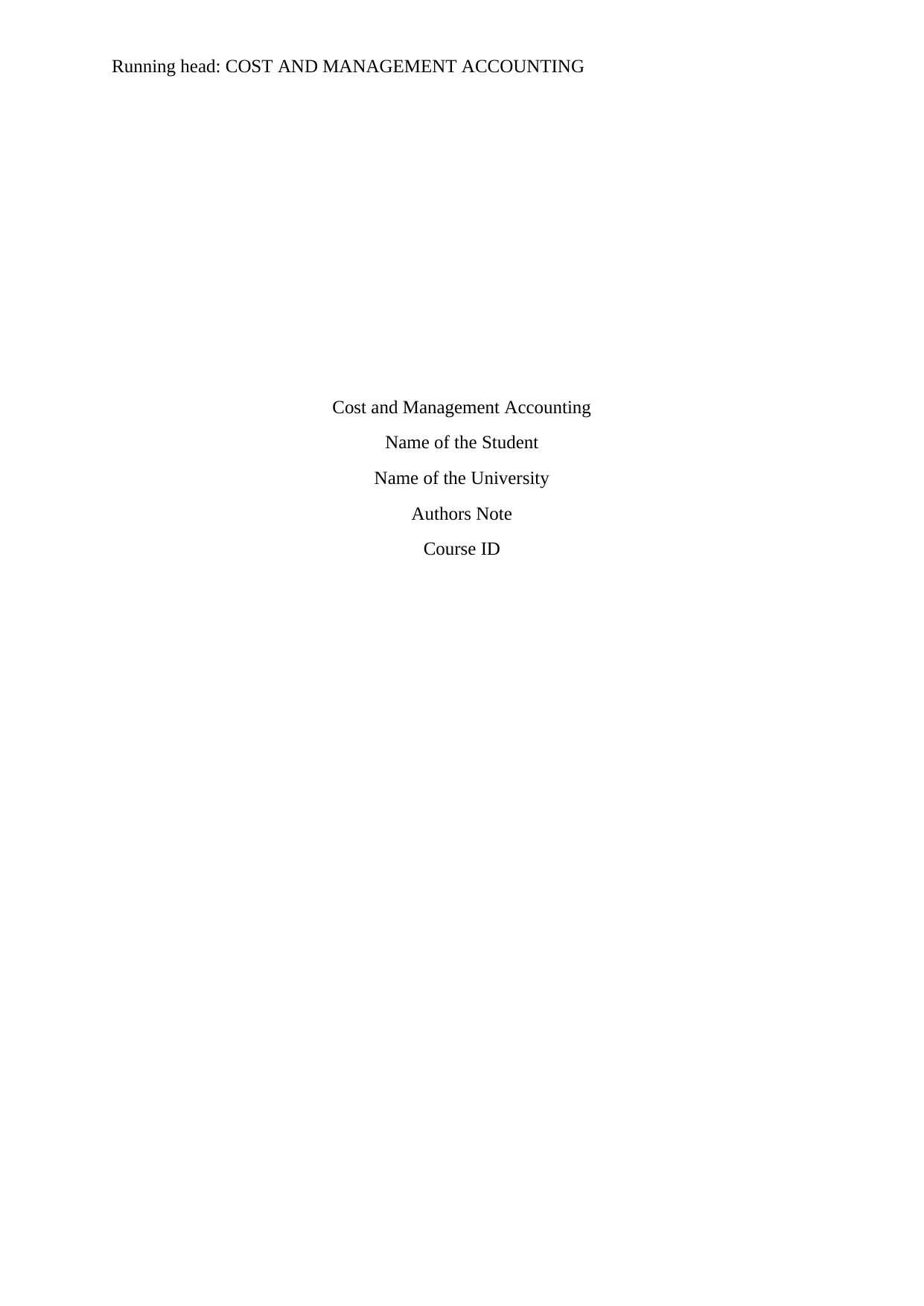
Running head: COST AND MANAGEMENT ACCOUNTING
Cost and Management Accounting
Name of the Student
Name of the University
Authors Note
Course ID
Cost and Management Accounting
Name of the Student
Name of the University
Authors Note
Course ID
Paraphrase This Document
Need a fresh take? Get an instant paraphrase of this document with our AI Paraphraser
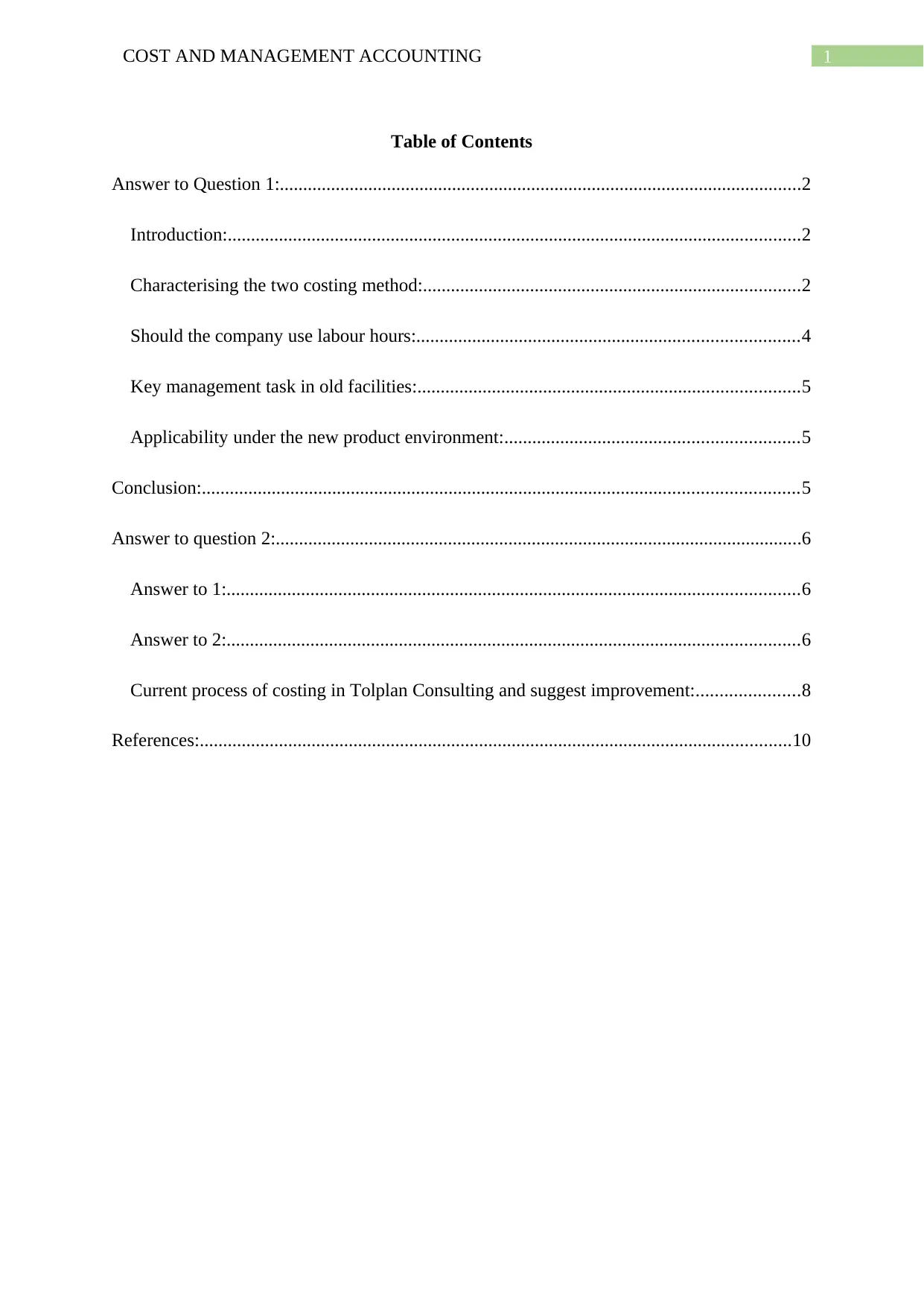
1COST AND MANAGEMENT ACCOUNTING
Table of Contents
Answer to Question 1:................................................................................................................2
Introduction:...........................................................................................................................2
Characterising the two costing method:.................................................................................2
Should the company use labour hours:..................................................................................4
Key management task in old facilities:..................................................................................5
Applicability under the new product environment:...............................................................5
Conclusion:................................................................................................................................5
Answer to question 2:.................................................................................................................6
Answer to 1:...........................................................................................................................6
Answer to 2:...........................................................................................................................6
Current process of costing in Tolplan Consulting and suggest improvement:......................8
References:...............................................................................................................................10
Table of Contents
Answer to Question 1:................................................................................................................2
Introduction:...........................................................................................................................2
Characterising the two costing method:.................................................................................2
Should the company use labour hours:..................................................................................4
Key management task in old facilities:..................................................................................5
Applicability under the new product environment:...............................................................5
Conclusion:................................................................................................................................5
Answer to question 2:.................................................................................................................6
Answer to 1:...........................................................................................................................6
Answer to 2:...........................................................................................................................6
Current process of costing in Tolplan Consulting and suggest improvement:......................8
References:...............................................................................................................................10
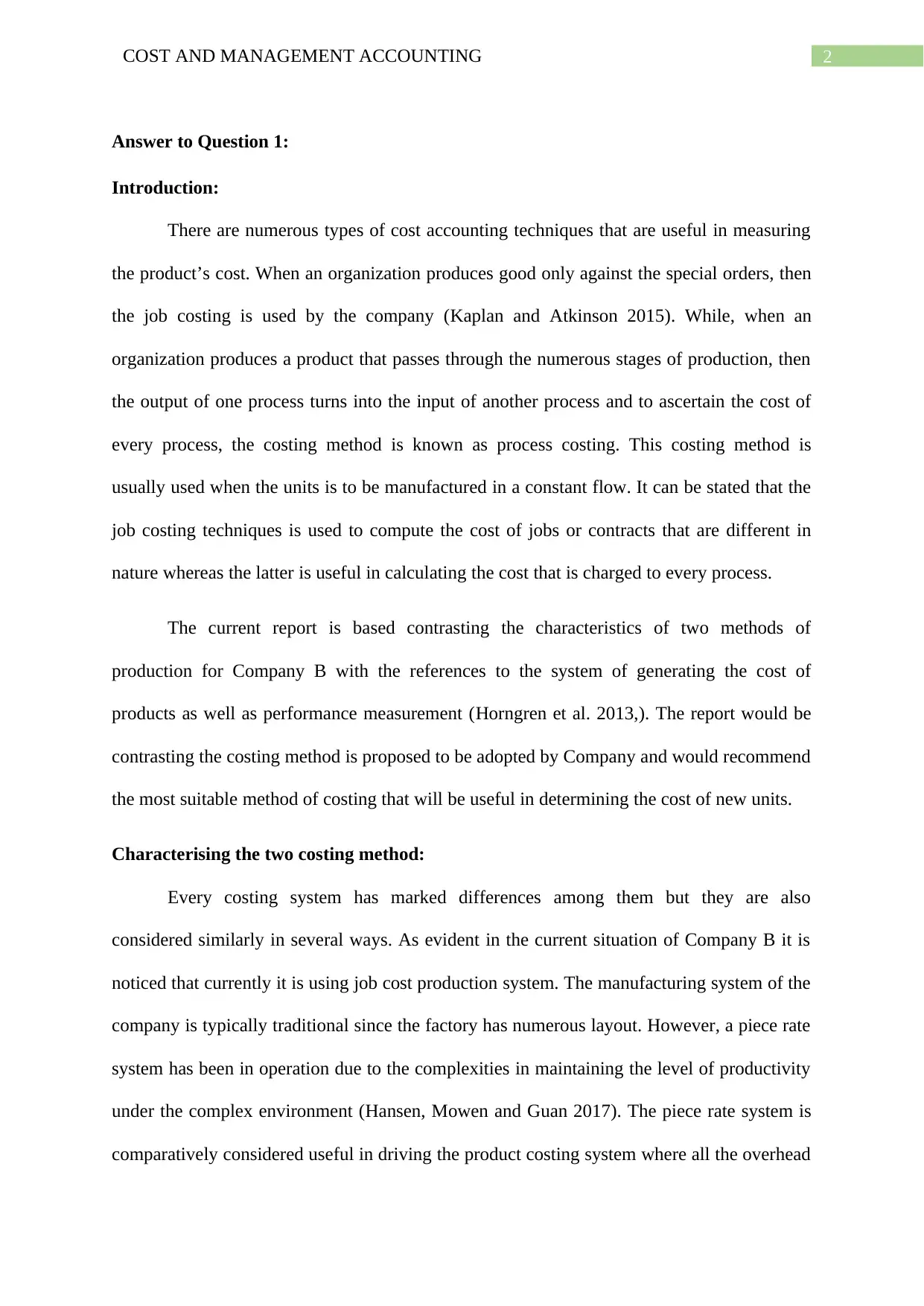
2COST AND MANAGEMENT ACCOUNTING
Answer to Question 1:
Introduction:
There are numerous types of cost accounting techniques that are useful in measuring
the product’s cost. When an organization produces good only against the special orders, then
the job costing is used by the company (Kaplan and Atkinson 2015). While, when an
organization produces a product that passes through the numerous stages of production, then
the output of one process turns into the input of another process and to ascertain the cost of
every process, the costing method is known as process costing. This costing method is
usually used when the units is to be manufactured in a constant flow. It can be stated that the
job costing techniques is used to compute the cost of jobs or contracts that are different in
nature whereas the latter is useful in calculating the cost that is charged to every process.
The current report is based contrasting the characteristics of two methods of
production for Company B with the references to the system of generating the cost of
products as well as performance measurement (Horngren et al. 2013,). The report would be
contrasting the costing method is proposed to be adopted by Company and would recommend
the most suitable method of costing that will be useful in determining the cost of new units.
Characterising the two costing method:
Every costing system has marked differences among them but they are also
considered similarly in several ways. As evident in the current situation of Company B it is
noticed that currently it is using job cost production system. The manufacturing system of the
company is typically traditional since the factory has numerous layout. However, a piece rate
system has been in operation due to the complexities in maintaining the level of productivity
under the complex environment (Hansen, Mowen and Guan 2017). The piece rate system is
comparatively considered useful in driving the product costing system where all the overhead
Answer to Question 1:
Introduction:
There are numerous types of cost accounting techniques that are useful in measuring
the product’s cost. When an organization produces good only against the special orders, then
the job costing is used by the company (Kaplan and Atkinson 2015). While, when an
organization produces a product that passes through the numerous stages of production, then
the output of one process turns into the input of another process and to ascertain the cost of
every process, the costing method is known as process costing. This costing method is
usually used when the units is to be manufactured in a constant flow. It can be stated that the
job costing techniques is used to compute the cost of jobs or contracts that are different in
nature whereas the latter is useful in calculating the cost that is charged to every process.
The current report is based contrasting the characteristics of two methods of
production for Company B with the references to the system of generating the cost of
products as well as performance measurement (Horngren et al. 2013,). The report would be
contrasting the costing method is proposed to be adopted by Company and would recommend
the most suitable method of costing that will be useful in determining the cost of new units.
Characterising the two costing method:
Every costing system has marked differences among them but they are also
considered similarly in several ways. As evident in the current situation of Company B it is
noticed that currently it is using job cost production system. The manufacturing system of the
company is typically traditional since the factory has numerous layout. However, a piece rate
system has been in operation due to the complexities in maintaining the level of productivity
under the complex environment (Hansen, Mowen and Guan 2017). The piece rate system is
comparatively considered useful in driving the product costing system where all the overhead
⊘ This is a preview!⊘
Do you want full access?
Subscribe today to unlock all pages.

Trusted by 1+ million students worldwide
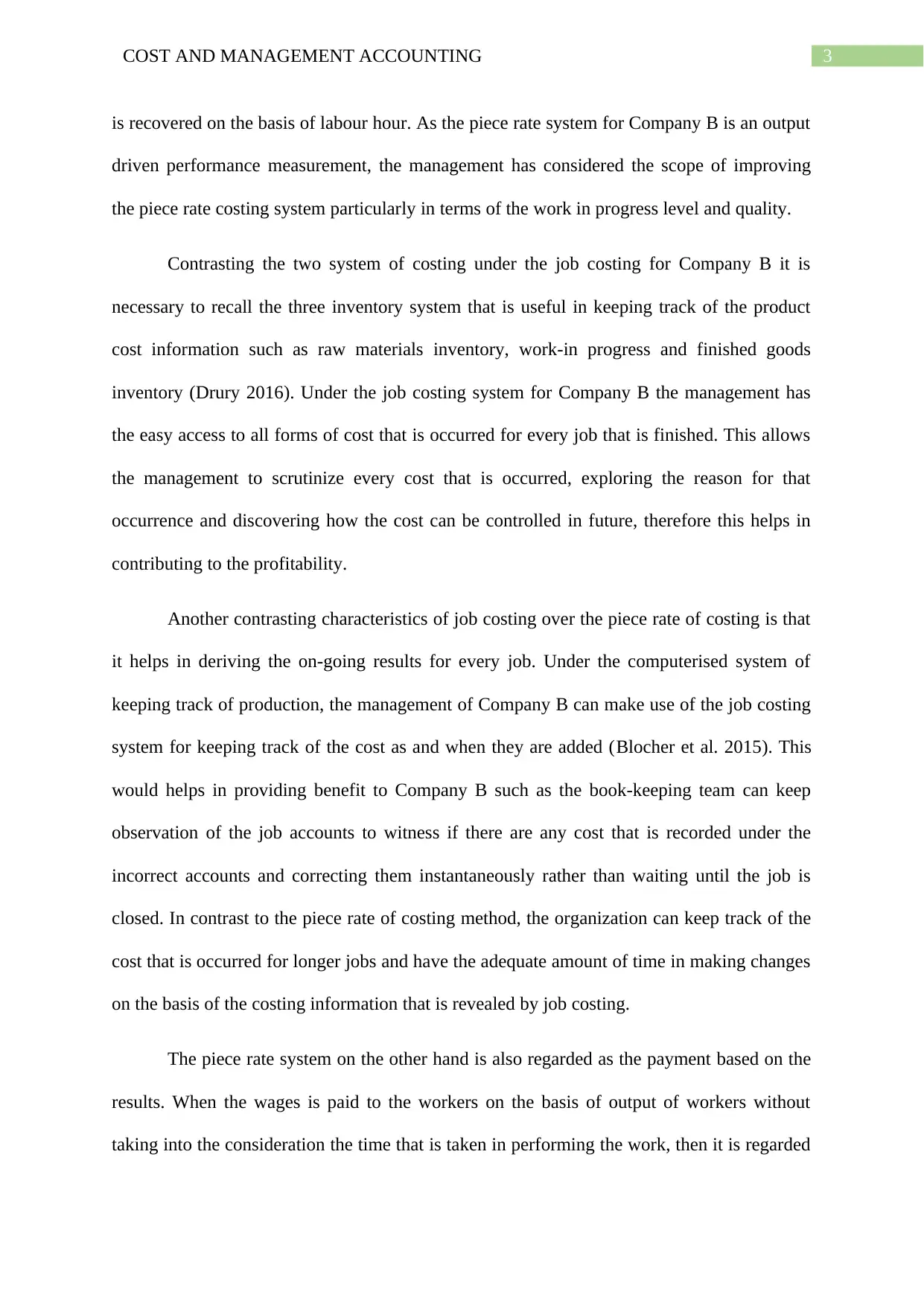
3COST AND MANAGEMENT ACCOUNTING
is recovered on the basis of labour hour. As the piece rate system for Company B is an output
driven performance measurement, the management has considered the scope of improving
the piece rate costing system particularly in terms of the work in progress level and quality.
Contrasting the two system of costing under the job costing for Company B it is
necessary to recall the three inventory system that is useful in keeping track of the product
cost information such as raw materials inventory, work-in progress and finished goods
inventory (Drury 2016). Under the job costing system for Company B the management has
the easy access to all forms of cost that is occurred for every job that is finished. This allows
the management to scrutinize every cost that is occurred, exploring the reason for that
occurrence and discovering how the cost can be controlled in future, therefore this helps in
contributing to the profitability.
Another contrasting characteristics of job costing over the piece rate of costing is that
it helps in deriving the on-going results for every job. Under the computerised system of
keeping track of production, the management of Company B can make use of the job costing
system for keeping track of the cost as and when they are added (Blocher et al. 2015). This
would helps in providing benefit to Company B such as the book-keeping team can keep
observation of the job accounts to witness if there are any cost that is recorded under the
incorrect accounts and correcting them instantaneously rather than waiting until the job is
closed. In contrast to the piece rate of costing method, the organization can keep track of the
cost that is occurred for longer jobs and have the adequate amount of time in making changes
on the basis of the costing information that is revealed by job costing.
The piece rate system on the other hand is also regarded as the payment based on the
results. When the wages is paid to the workers on the basis of output of workers without
taking into the consideration the time that is taken in performing the work, then it is regarded
is recovered on the basis of labour hour. As the piece rate system for Company B is an output
driven performance measurement, the management has considered the scope of improving
the piece rate costing system particularly in terms of the work in progress level and quality.
Contrasting the two system of costing under the job costing for Company B it is
necessary to recall the three inventory system that is useful in keeping track of the product
cost information such as raw materials inventory, work-in progress and finished goods
inventory (Drury 2016). Under the job costing system for Company B the management has
the easy access to all forms of cost that is occurred for every job that is finished. This allows
the management to scrutinize every cost that is occurred, exploring the reason for that
occurrence and discovering how the cost can be controlled in future, therefore this helps in
contributing to the profitability.
Another contrasting characteristics of job costing over the piece rate of costing is that
it helps in deriving the on-going results for every job. Under the computerised system of
keeping track of production, the management of Company B can make use of the job costing
system for keeping track of the cost as and when they are added (Blocher et al. 2015). This
would helps in providing benefit to Company B such as the book-keeping team can keep
observation of the job accounts to witness if there are any cost that is recorded under the
incorrect accounts and correcting them instantaneously rather than waiting until the job is
closed. In contrast to the piece rate of costing method, the organization can keep track of the
cost that is occurred for longer jobs and have the adequate amount of time in making changes
on the basis of the costing information that is revealed by job costing.
The piece rate system on the other hand is also regarded as the payment based on the
results. When the wages is paid to the workers on the basis of output of workers without
taking into the consideration the time that is taken in performing the work, then it is regarded
Paraphrase This Document
Need a fresh take? Get an instant paraphrase of this document with our AI Paraphraser
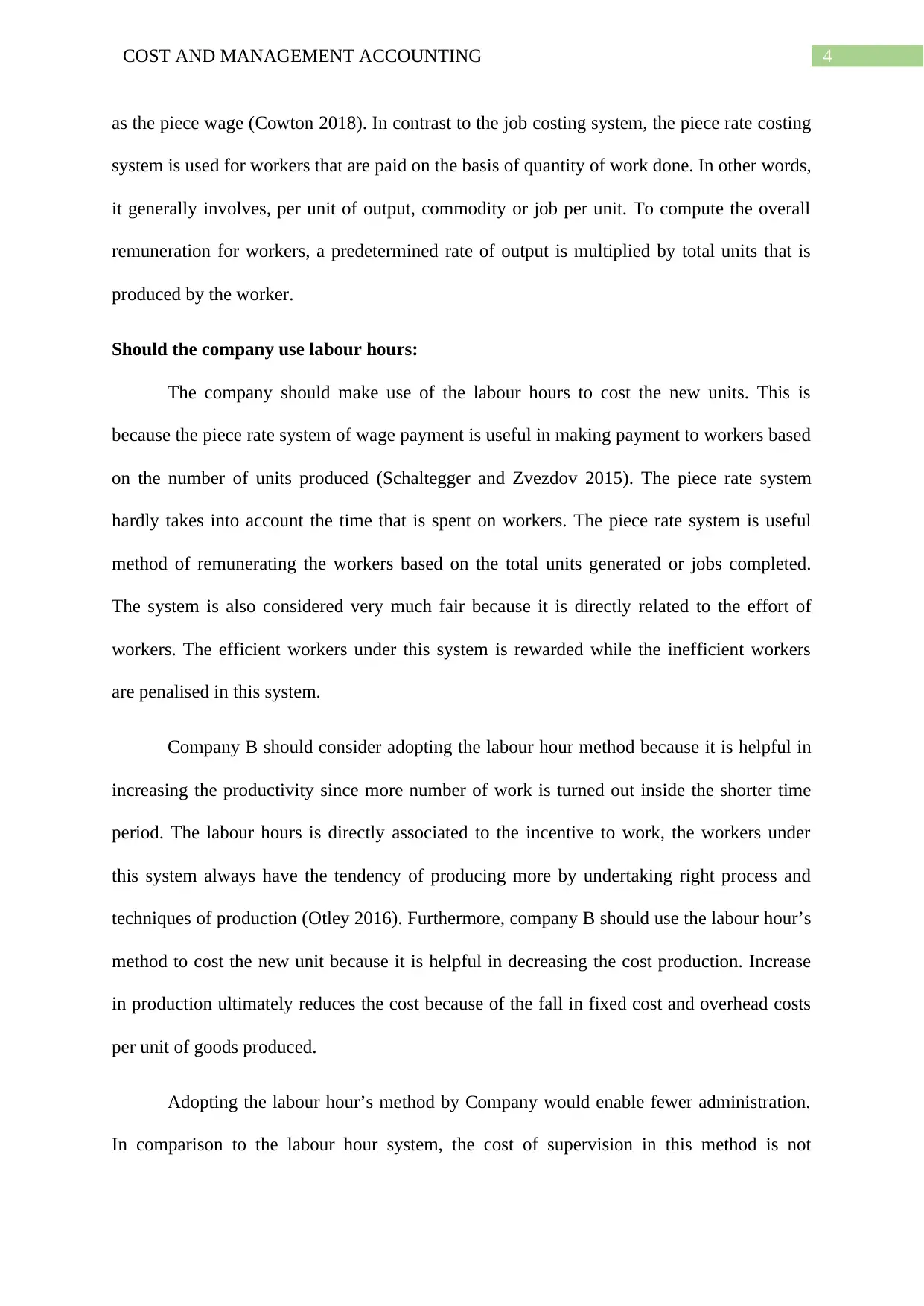
4COST AND MANAGEMENT ACCOUNTING
as the piece wage (Cowton 2018). In contrast to the job costing system, the piece rate costing
system is used for workers that are paid on the basis of quantity of work done. In other words,
it generally involves, per unit of output, commodity or job per unit. To compute the overall
remuneration for workers, a predetermined rate of output is multiplied by total units that is
produced by the worker.
Should the company use labour hours:
The company should make use of the labour hours to cost the new units. This is
because the piece rate system of wage payment is useful in making payment to workers based
on the number of units produced (Schaltegger and Zvezdov 2015). The piece rate system
hardly takes into account the time that is spent on workers. The piece rate system is useful
method of remunerating the workers based on the total units generated or jobs completed.
The system is also considered very much fair because it is directly related to the effort of
workers. The efficient workers under this system is rewarded while the inefficient workers
are penalised in this system.
Company B should consider adopting the labour hour method because it is helpful in
increasing the productivity since more number of work is turned out inside the shorter time
period. The labour hours is directly associated to the incentive to work, the workers under
this system always have the tendency of producing more by undertaking right process and
techniques of production (Otley 2016). Furthermore, company B should use the labour hour’s
method to cost the new unit because it is helpful in decreasing the cost production. Increase
in production ultimately reduces the cost because of the fall in fixed cost and overhead costs
per unit of goods produced.
Adopting the labour hour’s method by Company would enable fewer administration.
In comparison to the labour hour system, the cost of supervision in this method is not
as the piece wage (Cowton 2018). In contrast to the job costing system, the piece rate costing
system is used for workers that are paid on the basis of quantity of work done. In other words,
it generally involves, per unit of output, commodity or job per unit. To compute the overall
remuneration for workers, a predetermined rate of output is multiplied by total units that is
produced by the worker.
Should the company use labour hours:
The company should make use of the labour hours to cost the new units. This is
because the piece rate system of wage payment is useful in making payment to workers based
on the number of units produced (Schaltegger and Zvezdov 2015). The piece rate system
hardly takes into account the time that is spent on workers. The piece rate system is useful
method of remunerating the workers based on the total units generated or jobs completed.
The system is also considered very much fair because it is directly related to the effort of
workers. The efficient workers under this system is rewarded while the inefficient workers
are penalised in this system.
Company B should consider adopting the labour hour method because it is helpful in
increasing the productivity since more number of work is turned out inside the shorter time
period. The labour hours is directly associated to the incentive to work, the workers under
this system always have the tendency of producing more by undertaking right process and
techniques of production (Otley 2016). Furthermore, company B should use the labour hour’s
method to cost the new unit because it is helpful in decreasing the cost production. Increase
in production ultimately reduces the cost because of the fall in fixed cost and overhead costs
per unit of goods produced.
Adopting the labour hour’s method by Company would enable fewer administration.
In comparison to the labour hour system, the cost of supervision in this method is not
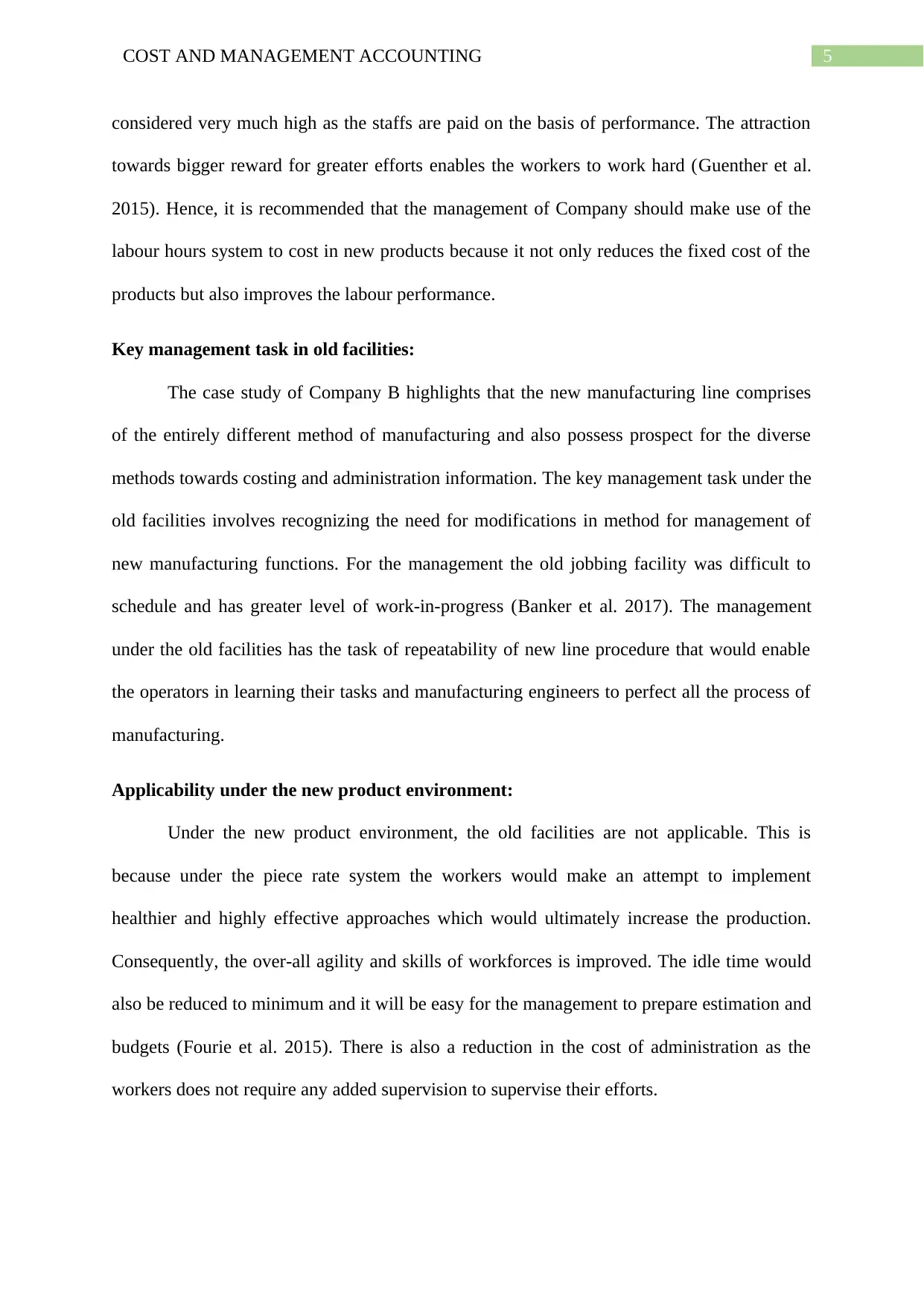
5COST AND MANAGEMENT ACCOUNTING
considered very much high as the staffs are paid on the basis of performance. The attraction
towards bigger reward for greater efforts enables the workers to work hard (Guenther et al.
2015). Hence, it is recommended that the management of Company should make use of the
labour hours system to cost in new products because it not only reduces the fixed cost of the
products but also improves the labour performance.
Key management task in old facilities:
The case study of Company B highlights that the new manufacturing line comprises
of the entirely different method of manufacturing and also possess prospect for the diverse
methods towards costing and administration information. The key management task under the
old facilities involves recognizing the need for modifications in method for management of
new manufacturing functions. For the management the old jobbing facility was difficult to
schedule and has greater level of work-in-progress (Banker et al. 2017). The management
under the old facilities has the task of repeatability of new line procedure that would enable
the operators in learning their tasks and manufacturing engineers to perfect all the process of
manufacturing.
Applicability under the new product environment:
Under the new product environment, the old facilities are not applicable. This is
because under the piece rate system the workers would make an attempt to implement
healthier and highly effective approaches which would ultimately increase the production.
Consequently, the over-all agility and skills of workforces is improved. The idle time would
also be reduced to minimum and it will be easy for the management to prepare estimation and
budgets (Fourie et al. 2015). There is also a reduction in the cost of administration as the
workers does not require any added supervision to supervise their efforts.
considered very much high as the staffs are paid on the basis of performance. The attraction
towards bigger reward for greater efforts enables the workers to work hard (Guenther et al.
2015). Hence, it is recommended that the management of Company should make use of the
labour hours system to cost in new products because it not only reduces the fixed cost of the
products but also improves the labour performance.
Key management task in old facilities:
The case study of Company B highlights that the new manufacturing line comprises
of the entirely different method of manufacturing and also possess prospect for the diverse
methods towards costing and administration information. The key management task under the
old facilities involves recognizing the need for modifications in method for management of
new manufacturing functions. For the management the old jobbing facility was difficult to
schedule and has greater level of work-in-progress (Banker et al. 2017). The management
under the old facilities has the task of repeatability of new line procedure that would enable
the operators in learning their tasks and manufacturing engineers to perfect all the process of
manufacturing.
Applicability under the new product environment:
Under the new product environment, the old facilities are not applicable. This is
because under the piece rate system the workers would make an attempt to implement
healthier and highly effective approaches which would ultimately increase the production.
Consequently, the over-all agility and skills of workforces is improved. The idle time would
also be reduced to minimum and it will be easy for the management to prepare estimation and
budgets (Fourie et al. 2015). There is also a reduction in the cost of administration as the
workers does not require any added supervision to supervise their efforts.
⊘ This is a preview!⊘
Do you want full access?
Subscribe today to unlock all pages.

Trusted by 1+ million students worldwide
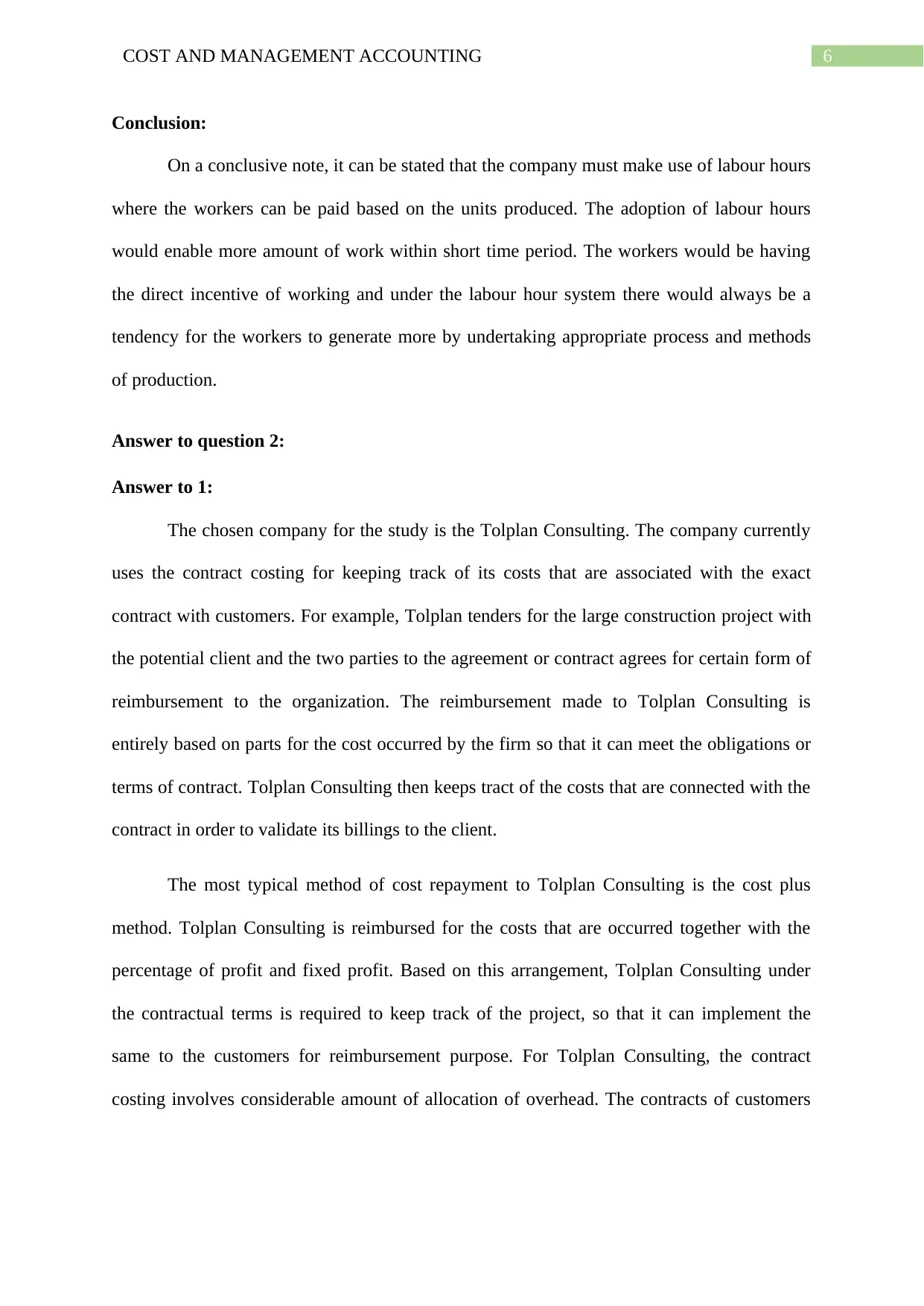
6COST AND MANAGEMENT ACCOUNTING
Conclusion:
On a conclusive note, it can be stated that the company must make use of labour hours
where the workers can be paid based on the units produced. The adoption of labour hours
would enable more amount of work within short time period. The workers would be having
the direct incentive of working and under the labour hour system there would always be a
tendency for the workers to generate more by undertaking appropriate process and methods
of production.
Answer to question 2:
Answer to 1:
The chosen company for the study is the Tolplan Consulting. The company currently
uses the contract costing for keeping track of its costs that are associated with the exact
contract with customers. For example, Tolplan tenders for the large construction project with
the potential client and the two parties to the agreement or contract agrees for certain form of
reimbursement to the organization. The reimbursement made to Tolplan Consulting is
entirely based on parts for the cost occurred by the firm so that it can meet the obligations or
terms of contract. Tolplan Consulting then keeps tract of the costs that are connected with the
contract in order to validate its billings to the client.
The most typical method of cost repayment to Tolplan Consulting is the cost plus
method. Tolplan Consulting is reimbursed for the costs that are occurred together with the
percentage of profit and fixed profit. Based on this arrangement, Tolplan Consulting under
the contractual terms is required to keep track of the project, so that it can implement the
same to the customers for reimbursement purpose. For Tolplan Consulting, the contract
costing involves considerable amount of allocation of overhead. The contracts of customers
Conclusion:
On a conclusive note, it can be stated that the company must make use of labour hours
where the workers can be paid based on the units produced. The adoption of labour hours
would enable more amount of work within short time period. The workers would be having
the direct incentive of working and under the labour hour system there would always be a
tendency for the workers to generate more by undertaking appropriate process and methods
of production.
Answer to question 2:
Answer to 1:
The chosen company for the study is the Tolplan Consulting. The company currently
uses the contract costing for keeping track of its costs that are associated with the exact
contract with customers. For example, Tolplan tenders for the large construction project with
the potential client and the two parties to the agreement or contract agrees for certain form of
reimbursement to the organization. The reimbursement made to Tolplan Consulting is
entirely based on parts for the cost occurred by the firm so that it can meet the obligations or
terms of contract. Tolplan Consulting then keeps tract of the costs that are connected with the
contract in order to validate its billings to the client.
The most typical method of cost repayment to Tolplan Consulting is the cost plus
method. Tolplan Consulting is reimbursed for the costs that are occurred together with the
percentage of profit and fixed profit. Based on this arrangement, Tolplan Consulting under
the contractual terms is required to keep track of the project, so that it can implement the
same to the customers for reimbursement purpose. For Tolplan Consulting, the contract
costing involves considerable amount of allocation of overhead. The contracts of customers
Paraphrase This Document
Need a fresh take? Get an instant paraphrase of this document with our AI Paraphraser
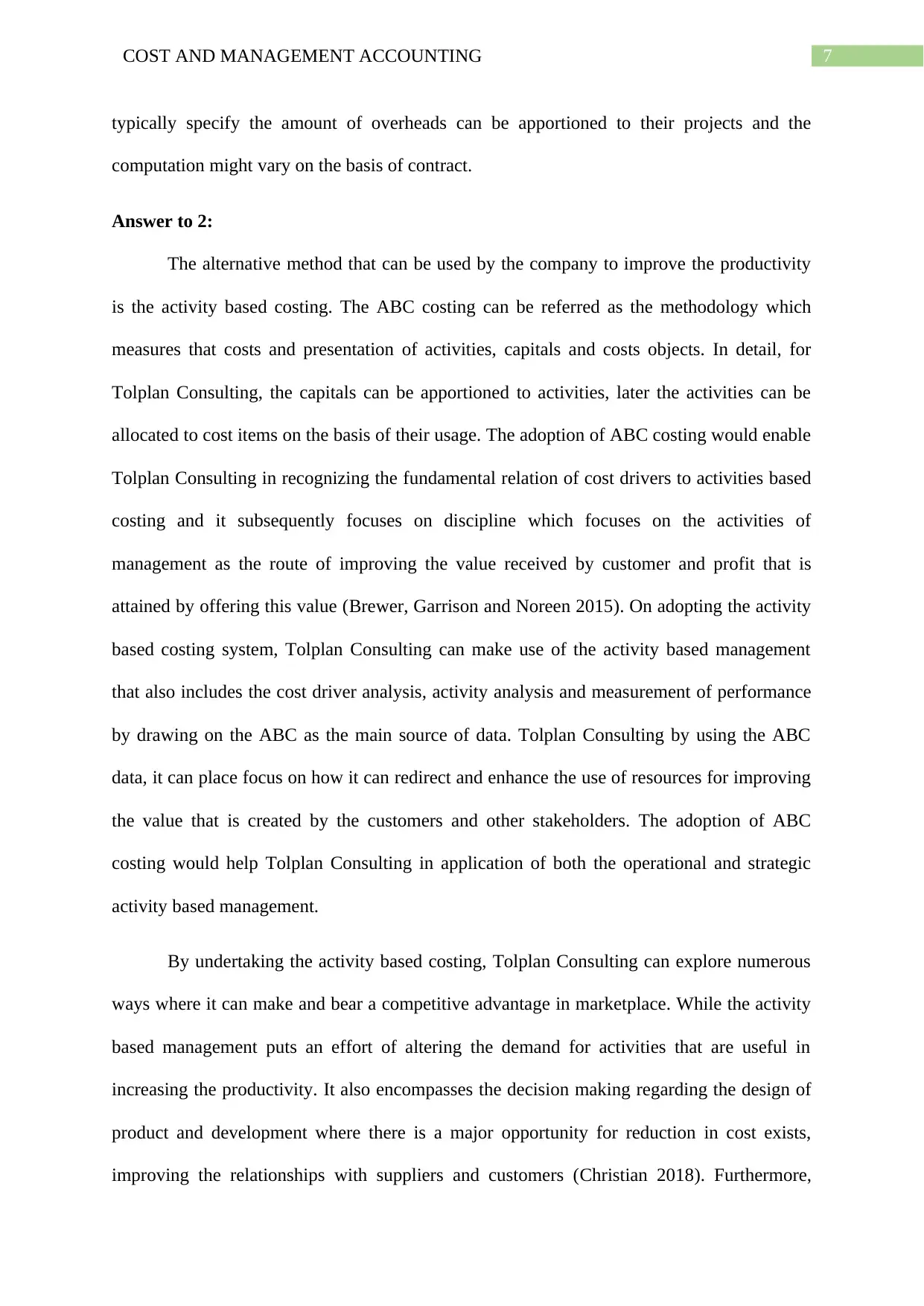
7COST AND MANAGEMENT ACCOUNTING
typically specify the amount of overheads can be apportioned to their projects and the
computation might vary on the basis of contract.
Answer to 2:
The alternative method that can be used by the company to improve the productivity
is the activity based costing. The ABC costing can be referred as the methodology which
measures that costs and presentation of activities, capitals and costs objects. In detail, for
Tolplan Consulting, the capitals can be apportioned to activities, later the activities can be
allocated to cost items on the basis of their usage. The adoption of ABC costing would enable
Tolplan Consulting in recognizing the fundamental relation of cost drivers to activities based
costing and it subsequently focuses on discipline which focuses on the activities of
management as the route of improving the value received by customer and profit that is
attained by offering this value (Brewer, Garrison and Noreen 2015). On adopting the activity
based costing system, Tolplan Consulting can make use of the activity based management
that also includes the cost driver analysis, activity analysis and measurement of performance
by drawing on the ABC as the main source of data. Tolplan Consulting by using the ABC
data, it can place focus on how it can redirect and enhance the use of resources for improving
the value that is created by the customers and other stakeholders. The adoption of ABC
costing would help Tolplan Consulting in application of both the operational and strategic
activity based management.
By undertaking the activity based costing, Tolplan Consulting can explore numerous
ways where it can make and bear a competitive advantage in marketplace. While the activity
based management puts an effort of altering the demand for activities that are useful in
increasing the productivity. It also encompasses the decision making regarding the design of
product and development where there is a major opportunity for reduction in cost exists,
improving the relationships with suppliers and customers (Christian 2018). Furthermore,
typically specify the amount of overheads can be apportioned to their projects and the
computation might vary on the basis of contract.
Answer to 2:
The alternative method that can be used by the company to improve the productivity
is the activity based costing. The ABC costing can be referred as the methodology which
measures that costs and presentation of activities, capitals and costs objects. In detail, for
Tolplan Consulting, the capitals can be apportioned to activities, later the activities can be
allocated to cost items on the basis of their usage. The adoption of ABC costing would enable
Tolplan Consulting in recognizing the fundamental relation of cost drivers to activities based
costing and it subsequently focuses on discipline which focuses on the activities of
management as the route of improving the value received by customer and profit that is
attained by offering this value (Brewer, Garrison and Noreen 2015). On adopting the activity
based costing system, Tolplan Consulting can make use of the activity based management
that also includes the cost driver analysis, activity analysis and measurement of performance
by drawing on the ABC as the main source of data. Tolplan Consulting by using the ABC
data, it can place focus on how it can redirect and enhance the use of resources for improving
the value that is created by the customers and other stakeholders. The adoption of ABC
costing would help Tolplan Consulting in application of both the operational and strategic
activity based management.
By undertaking the activity based costing, Tolplan Consulting can explore numerous
ways where it can make and bear a competitive advantage in marketplace. While the activity
based management puts an effort of altering the demand for activities that are useful in
increasing the productivity. It also encompasses the decision making regarding the design of
product and development where there is a major opportunity for reduction in cost exists,
improving the relationships with suppliers and customers (Christian 2018). Furthermore,
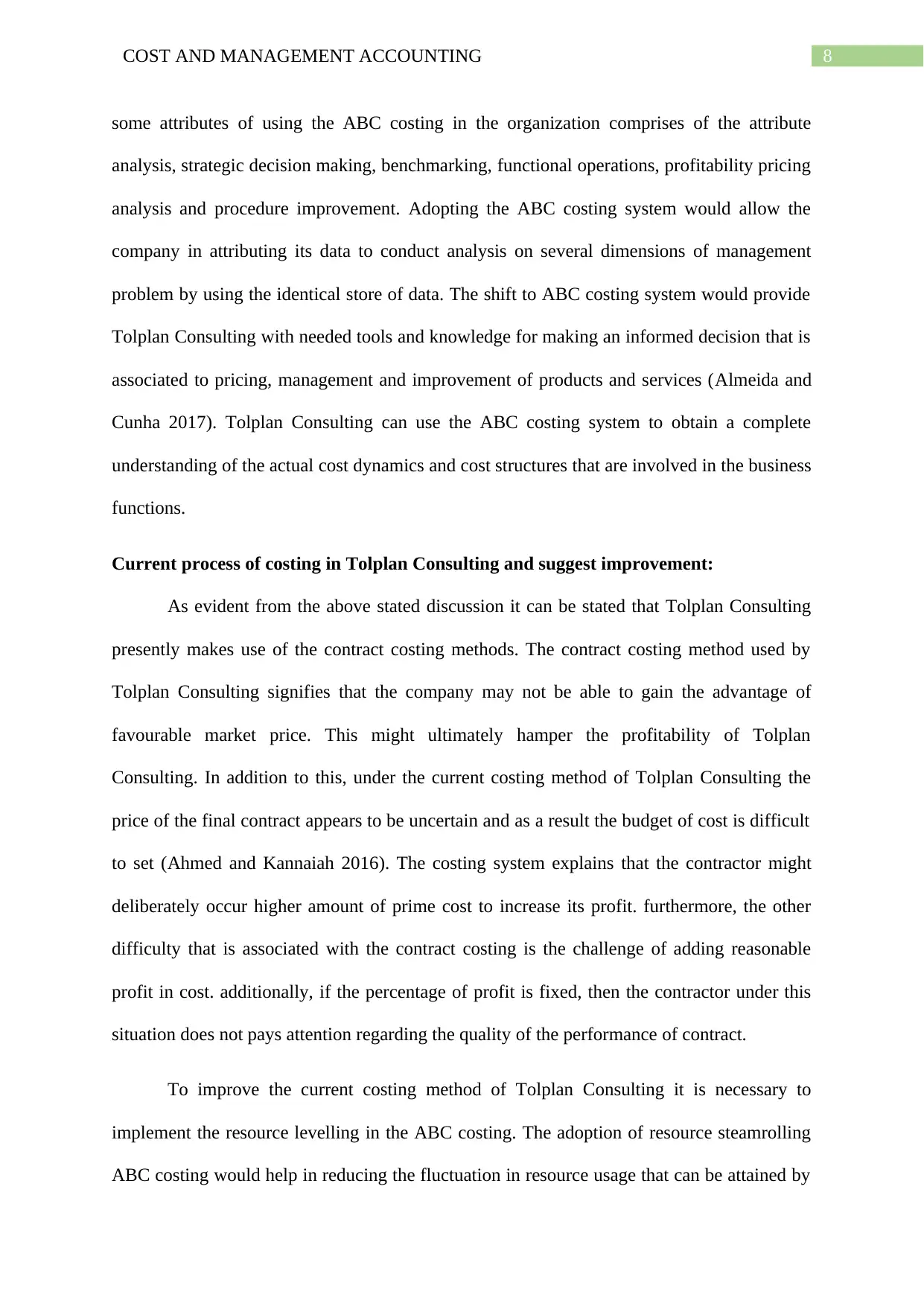
8COST AND MANAGEMENT ACCOUNTING
some attributes of using the ABC costing in the organization comprises of the attribute
analysis, strategic decision making, benchmarking, functional operations, profitability pricing
analysis and procedure improvement. Adopting the ABC costing system would allow the
company in attributing its data to conduct analysis on several dimensions of management
problem by using the identical store of data. The shift to ABC costing system would provide
Tolplan Consulting with needed tools and knowledge for making an informed decision that is
associated to pricing, management and improvement of products and services (Almeida and
Cunha 2017). Tolplan Consulting can use the ABC costing system to obtain a complete
understanding of the actual cost dynamics and cost structures that are involved in the business
functions.
Current process of costing in Tolplan Consulting and suggest improvement:
As evident from the above stated discussion it can be stated that Tolplan Consulting
presently makes use of the contract costing methods. The contract costing method used by
Tolplan Consulting signifies that the company may not be able to gain the advantage of
favourable market price. This might ultimately hamper the profitability of Tolplan
Consulting. In addition to this, under the current costing method of Tolplan Consulting the
price of the final contract appears to be uncertain and as a result the budget of cost is difficult
to set (Ahmed and Kannaiah 2016). The costing system explains that the contractor might
deliberately occur higher amount of prime cost to increase its profit. furthermore, the other
difficulty that is associated with the contract costing is the challenge of adding reasonable
profit in cost. additionally, if the percentage of profit is fixed, then the contractor under this
situation does not pays attention regarding the quality of the performance of contract.
To improve the current costing method of Tolplan Consulting it is necessary to
implement the resource levelling in the ABC costing. The adoption of resource steamrolling
ABC costing would help in reducing the fluctuation in resource usage that can be attained by
some attributes of using the ABC costing in the organization comprises of the attribute
analysis, strategic decision making, benchmarking, functional operations, profitability pricing
analysis and procedure improvement. Adopting the ABC costing system would allow the
company in attributing its data to conduct analysis on several dimensions of management
problem by using the identical store of data. The shift to ABC costing system would provide
Tolplan Consulting with needed tools and knowledge for making an informed decision that is
associated to pricing, management and improvement of products and services (Almeida and
Cunha 2017). Tolplan Consulting can use the ABC costing system to obtain a complete
understanding of the actual cost dynamics and cost structures that are involved in the business
functions.
Current process of costing in Tolplan Consulting and suggest improvement:
As evident from the above stated discussion it can be stated that Tolplan Consulting
presently makes use of the contract costing methods. The contract costing method used by
Tolplan Consulting signifies that the company may not be able to gain the advantage of
favourable market price. This might ultimately hamper the profitability of Tolplan
Consulting. In addition to this, under the current costing method of Tolplan Consulting the
price of the final contract appears to be uncertain and as a result the budget of cost is difficult
to set (Ahmed and Kannaiah 2016). The costing system explains that the contractor might
deliberately occur higher amount of prime cost to increase its profit. furthermore, the other
difficulty that is associated with the contract costing is the challenge of adding reasonable
profit in cost. additionally, if the percentage of profit is fixed, then the contractor under this
situation does not pays attention regarding the quality of the performance of contract.
To improve the current costing method of Tolplan Consulting it is necessary to
implement the resource levelling in the ABC costing. The adoption of resource steamrolling
ABC costing would help in reducing the fluctuation in resource usage that can be attained by
⊘ This is a preview!⊘
Do you want full access?
Subscribe today to unlock all pages.

Trusted by 1+ million students worldwide
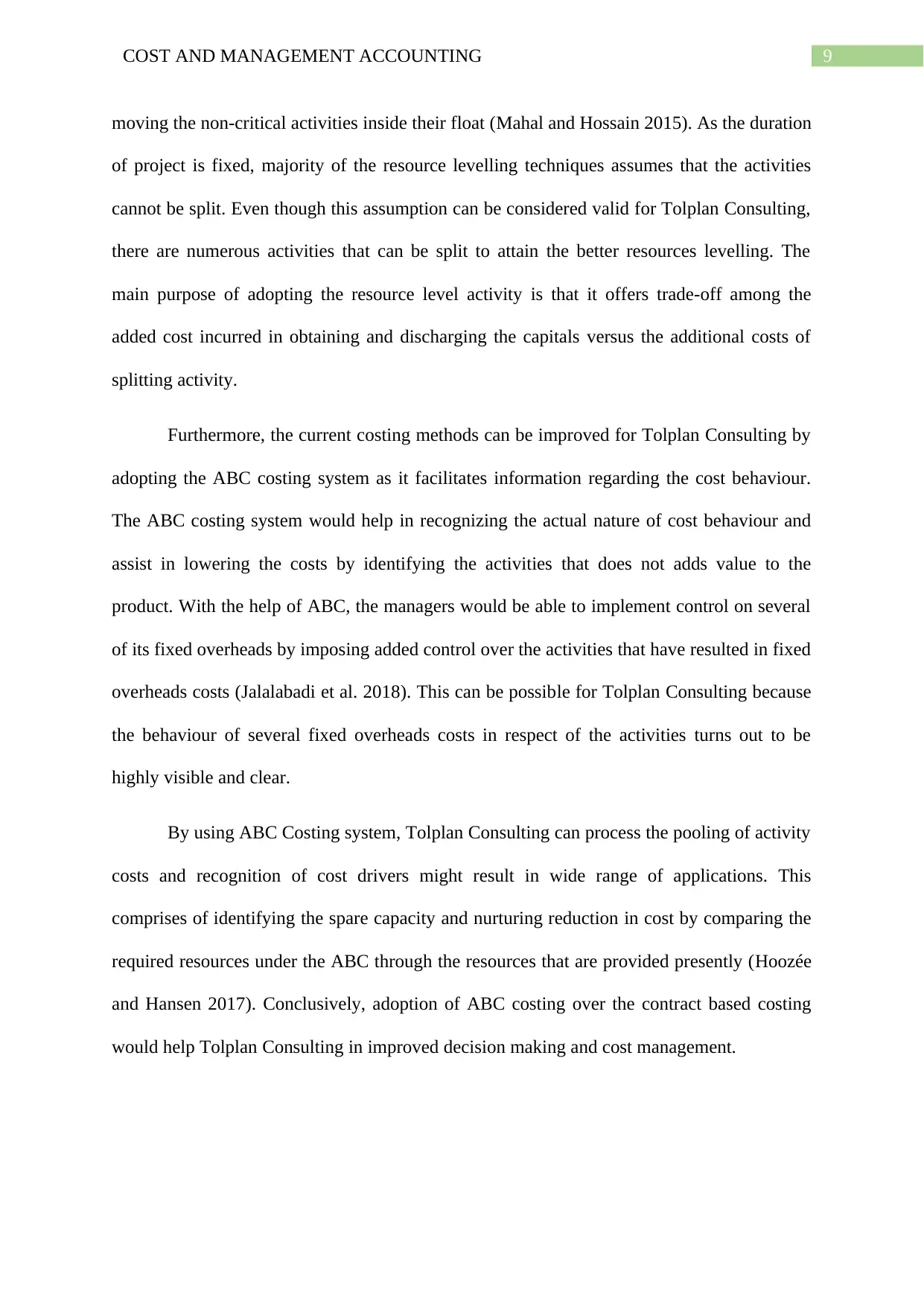
9COST AND MANAGEMENT ACCOUNTING
moving the non-critical activities inside their float (Mahal and Hossain 2015). As the duration
of project is fixed, majority of the resource levelling techniques assumes that the activities
cannot be split. Even though this assumption can be considered valid for Tolplan Consulting,
there are numerous activities that can be split to attain the better resources levelling. The
main purpose of adopting the resource level activity is that it offers trade-off among the
added cost incurred in obtaining and discharging the capitals versus the additional costs of
splitting activity.
Furthermore, the current costing methods can be improved for Tolplan Consulting by
adopting the ABC costing system as it facilitates information regarding the cost behaviour.
The ABC costing system would help in recognizing the actual nature of cost behaviour and
assist in lowering the costs by identifying the activities that does not adds value to the
product. With the help of ABC, the managers would be able to implement control on several
of its fixed overheads by imposing added control over the activities that have resulted in fixed
overheads costs (Jalalabadi et al. 2018). This can be possible for Tolplan Consulting because
the behaviour of several fixed overheads costs in respect of the activities turns out to be
highly visible and clear.
By using ABC Costing system, Tolplan Consulting can process the pooling of activity
costs and recognition of cost drivers might result in wide range of applications. This
comprises of identifying the spare capacity and nurturing reduction in cost by comparing the
required resources under the ABC through the resources that are provided presently (Hoozée
and Hansen 2017). Conclusively, adoption of ABC costing over the contract based costing
would help Tolplan Consulting in improved decision making and cost management.
moving the non-critical activities inside their float (Mahal and Hossain 2015). As the duration
of project is fixed, majority of the resource levelling techniques assumes that the activities
cannot be split. Even though this assumption can be considered valid for Tolplan Consulting,
there are numerous activities that can be split to attain the better resources levelling. The
main purpose of adopting the resource level activity is that it offers trade-off among the
added cost incurred in obtaining and discharging the capitals versus the additional costs of
splitting activity.
Furthermore, the current costing methods can be improved for Tolplan Consulting by
adopting the ABC costing system as it facilitates information regarding the cost behaviour.
The ABC costing system would help in recognizing the actual nature of cost behaviour and
assist in lowering the costs by identifying the activities that does not adds value to the
product. With the help of ABC, the managers would be able to implement control on several
of its fixed overheads by imposing added control over the activities that have resulted in fixed
overheads costs (Jalalabadi et al. 2018). This can be possible for Tolplan Consulting because
the behaviour of several fixed overheads costs in respect of the activities turns out to be
highly visible and clear.
By using ABC Costing system, Tolplan Consulting can process the pooling of activity
costs and recognition of cost drivers might result in wide range of applications. This
comprises of identifying the spare capacity and nurturing reduction in cost by comparing the
required resources under the ABC through the resources that are provided presently (Hoozée
and Hansen 2017). Conclusively, adoption of ABC costing over the contract based costing
would help Tolplan Consulting in improved decision making and cost management.
Paraphrase This Document
Need a fresh take? Get an instant paraphrase of this document with our AI Paraphraser
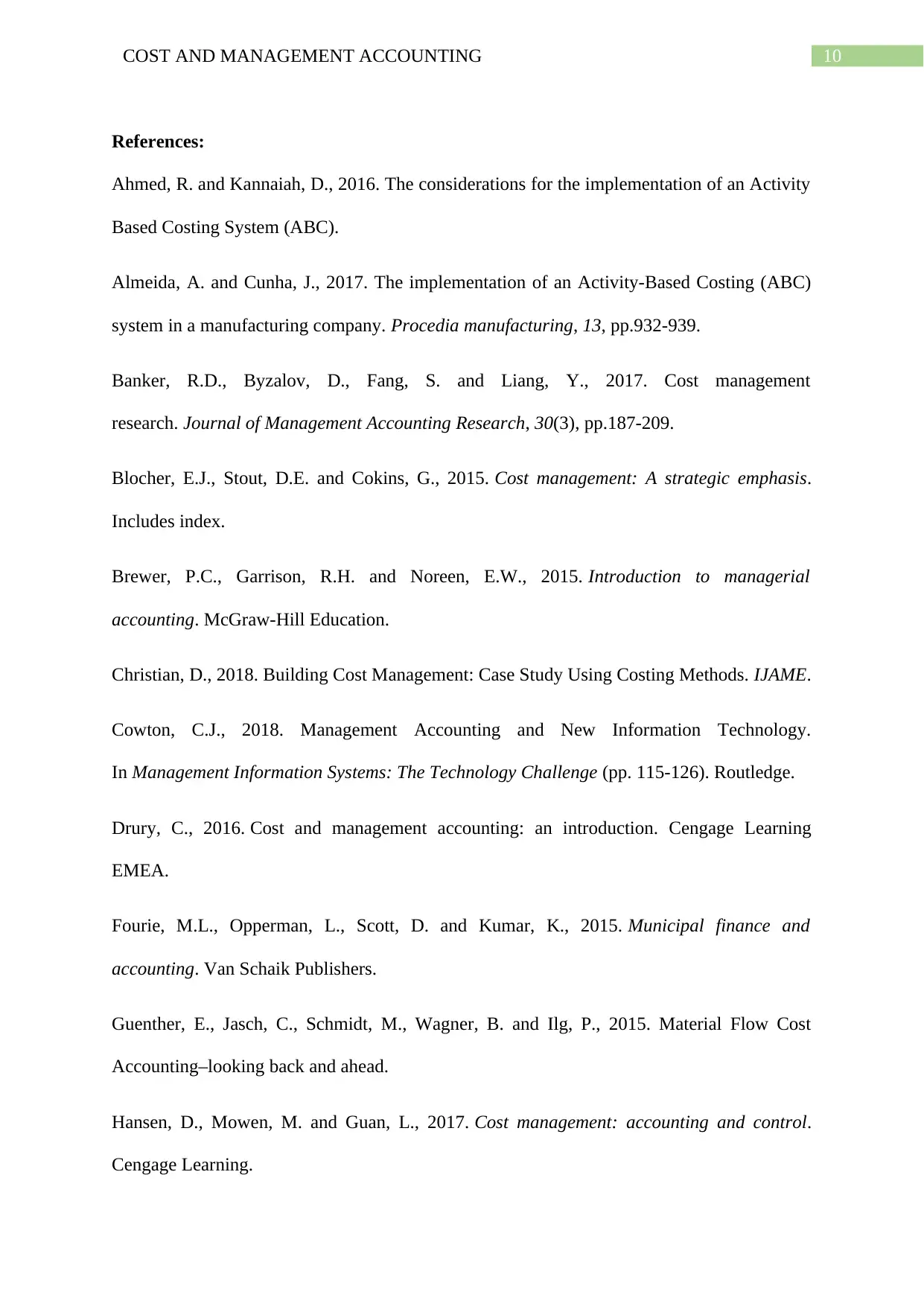
10COST AND MANAGEMENT ACCOUNTING
References:
Ahmed, R. and Kannaiah, D., 2016. The considerations for the implementation of an Activity
Based Costing System (ABC).
Almeida, A. and Cunha, J., 2017. The implementation of an Activity-Based Costing (ABC)
system in a manufacturing company. Procedia manufacturing, 13, pp.932-939.
Banker, R.D., Byzalov, D., Fang, S. and Liang, Y., 2017. Cost management
research. Journal of Management Accounting Research, 30(3), pp.187-209.
Blocher, E.J., Stout, D.E. and Cokins, G., 2015. Cost management: A strategic emphasis.
Includes index.
Brewer, P.C., Garrison, R.H. and Noreen, E.W., 2015. Introduction to managerial
accounting. McGraw-Hill Education.
Christian, D., 2018. Building Cost Management: Case Study Using Costing Methods. IJAME.
Cowton, C.J., 2018. Management Accounting and New Information Technology.
In Management Information Systems: The Technology Challenge (pp. 115-126). Routledge.
Drury, C., 2016. Cost and management accounting: an introduction. Cengage Learning
EMEA.
Fourie, M.L., Opperman, L., Scott, D. and Kumar, K., 2015. Municipal finance and
accounting. Van Schaik Publishers.
Guenther, E., Jasch, C., Schmidt, M., Wagner, B. and Ilg, P., 2015. Material Flow Cost
Accounting–looking back and ahead.
Hansen, D., Mowen, M. and Guan, L., 2017. Cost management: accounting and control.
Cengage Learning.
References:
Ahmed, R. and Kannaiah, D., 2016. The considerations for the implementation of an Activity
Based Costing System (ABC).
Almeida, A. and Cunha, J., 2017. The implementation of an Activity-Based Costing (ABC)
system in a manufacturing company. Procedia manufacturing, 13, pp.932-939.
Banker, R.D., Byzalov, D., Fang, S. and Liang, Y., 2017. Cost management
research. Journal of Management Accounting Research, 30(3), pp.187-209.
Blocher, E.J., Stout, D.E. and Cokins, G., 2015. Cost management: A strategic emphasis.
Includes index.
Brewer, P.C., Garrison, R.H. and Noreen, E.W., 2015. Introduction to managerial
accounting. McGraw-Hill Education.
Christian, D., 2018. Building Cost Management: Case Study Using Costing Methods. IJAME.
Cowton, C.J., 2018. Management Accounting and New Information Technology.
In Management Information Systems: The Technology Challenge (pp. 115-126). Routledge.
Drury, C., 2016. Cost and management accounting: an introduction. Cengage Learning
EMEA.
Fourie, M.L., Opperman, L., Scott, D. and Kumar, K., 2015. Municipal finance and
accounting. Van Schaik Publishers.
Guenther, E., Jasch, C., Schmidt, M., Wagner, B. and Ilg, P., 2015. Material Flow Cost
Accounting–looking back and ahead.
Hansen, D., Mowen, M. and Guan, L., 2017. Cost management: accounting and control.
Cengage Learning.
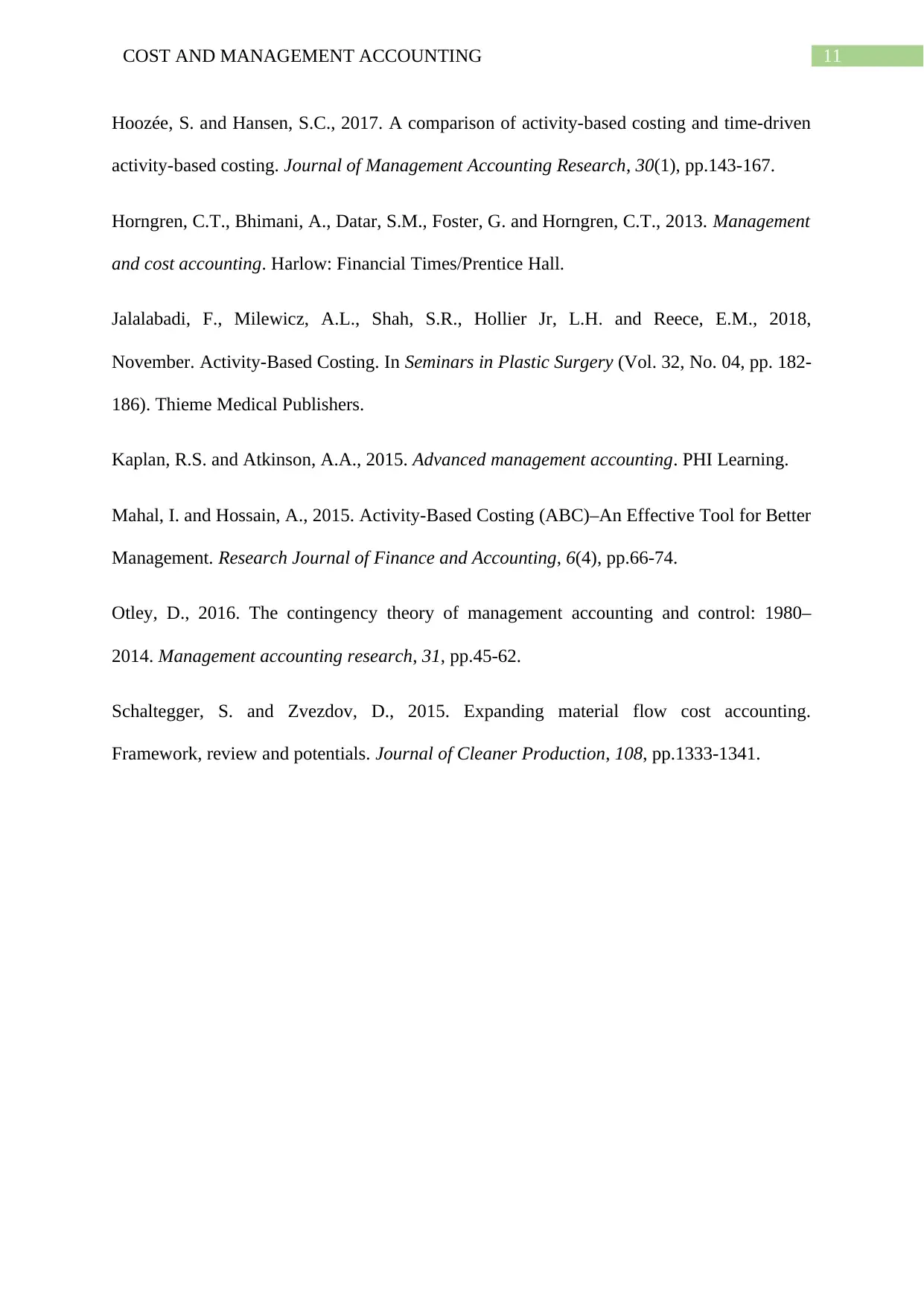
11COST AND MANAGEMENT ACCOUNTING
Hoozée, S. and Hansen, S.C., 2017. A comparison of activity-based costing and time-driven
activity-based costing. Journal of Management Accounting Research, 30(1), pp.143-167.
Horngren, C.T., Bhimani, A., Datar, S.M., Foster, G. and Horngren, C.T., 2013. Management
and cost accounting. Harlow: Financial Times/Prentice Hall.
Jalalabadi, F., Milewicz, A.L., Shah, S.R., Hollier Jr, L.H. and Reece, E.M., 2018,
November. Activity-Based Costing. In Seminars in Plastic Surgery (Vol. 32, No. 04, pp. 182-
186). Thieme Medical Publishers.
Kaplan, R.S. and Atkinson, A.A., 2015. Advanced management accounting. PHI Learning.
Mahal, I. and Hossain, A., 2015. Activity-Based Costing (ABC)–An Effective Tool for Better
Management. Research Journal of Finance and Accounting, 6(4), pp.66-74.
Otley, D., 2016. The contingency theory of management accounting and control: 1980–
2014. Management accounting research, 31, pp.45-62.
Schaltegger, S. and Zvezdov, D., 2015. Expanding material flow cost accounting.
Framework, review and potentials. Journal of Cleaner Production, 108, pp.1333-1341.
Hoozée, S. and Hansen, S.C., 2017. A comparison of activity-based costing and time-driven
activity-based costing. Journal of Management Accounting Research, 30(1), pp.143-167.
Horngren, C.T., Bhimani, A., Datar, S.M., Foster, G. and Horngren, C.T., 2013. Management
and cost accounting. Harlow: Financial Times/Prentice Hall.
Jalalabadi, F., Milewicz, A.L., Shah, S.R., Hollier Jr, L.H. and Reece, E.M., 2018,
November. Activity-Based Costing. In Seminars in Plastic Surgery (Vol. 32, No. 04, pp. 182-
186). Thieme Medical Publishers.
Kaplan, R.S. and Atkinson, A.A., 2015. Advanced management accounting. PHI Learning.
Mahal, I. and Hossain, A., 2015. Activity-Based Costing (ABC)–An Effective Tool for Better
Management. Research Journal of Finance and Accounting, 6(4), pp.66-74.
Otley, D., 2016. The contingency theory of management accounting and control: 1980–
2014. Management accounting research, 31, pp.45-62.
Schaltegger, S. and Zvezdov, D., 2015. Expanding material flow cost accounting.
Framework, review and potentials. Journal of Cleaner Production, 108, pp.1333-1341.
⊘ This is a preview!⊘
Do you want full access?
Subscribe today to unlock all pages.

Trusted by 1+ million students worldwide
1 out of 12
Related Documents
Your All-in-One AI-Powered Toolkit for Academic Success.
+13062052269
info@desklib.com
Available 24*7 on WhatsApp / Email
![[object Object]](/_next/static/media/star-bottom.7253800d.svg)
Unlock your academic potential
Copyright © 2020–2025 A2Z Services. All Rights Reserved. Developed and managed by ZUCOL.




